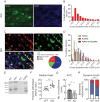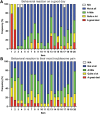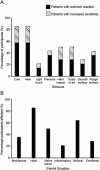Pain experience of children with Christianson syndrome
- PMID: 39945731
- PMCID: PMC12168814
- DOI: 10.1097/j.pain.0000000000003522
Pain experience of children with Christianson syndrome
Abstract
Children with Christianson syndrome (CS), an X-linked neurodevelopmental disorder caused by loss-of-function mutations in the alkali cation/proton exchanger SLC9A6/NHE6, display severe cognitive impairments, mutism, and sensory abnormalities such as hyposensitivity to pain. However, it is unclear whether these children display other sensory abnormalities and whether their pain hyposensitivity is the result of an elevated pain threshold or a complete insensitivity to pain. To better characterize the sensory abnormalities in this disorder, we used a combination of a mouse model of CS and pain questionnaires directed at nonverbal patients with CS. We recruited 14 young male participants with CS and subjected them to a novel observational tool, the Pain Sensory and Painful Situations Questionnaire (PSQ), which takes multiple painful situations into account to broaden the description of pain expression. By analyzing social expressive behaviours of pain in these nonverbal patients, the PSQ documented that over 60% of the participants were unaffected by mechanical or inflammatory painful stimuli. This reduced pain sensitivity was also observed in the mouse CS model. Surprisingly, CS mice also displayed aversive reactions to innocuous stimuli, which prompted us to examine whether such reactions were also present in children with CS. Indeed, the results from the PSQ revealed that 30% to 50% of these patients showed an aversive response to normally innocuous stimuli like light touch and gusts of air. Our results demonstrate that children with CS have aversive reactions to innocuous stimuli and are hyposensitive to painful stimuli, the latter making them at risk for developing complications from unreported injuries.
Keywords: Children; Christianson syndrome; Pain; Touch aversion.
Copyright © 2025 The Author(s). Published by Wolters Kluwer Health, Inc. on behalf of the International Association for the Study of Pain.
Conflict of interest statement
The authors have no conflicts of interest to declare.
Sponsorships or competing interests that may be relevant to content are disclosed at the end of this article.
Figures




References
-
- Amir RE, Van den Veyver IB, Wan M, Tran CQ, Francke U, Zoghbi HY. Rett syndrome is caused by mutations in X-linked MECP2, encoding methyl-CpG-binding protein 2. Nat Genet 1999;23:185–8. - PubMed
-
- Baranek GT. Autism during infancy: a retrospective video analysis of sensory-motor and social behaviors at 9–12 months of age. J Autism Dev Disord 1999;29:213–24. - PubMed
-
- Bradbury EJ, Burnstock G, McMahon SB. The expression of P2X3 purinoreceptors in sensory neurons: effects of axotomy and glial-derived neurotrophic factor. Mol Cell Neurosci 1998;12:256–68. - PubMed
MeSH terms
Supplementary concepts
Grants and funding
LinkOut - more resources
Full Text Sources
Medical

